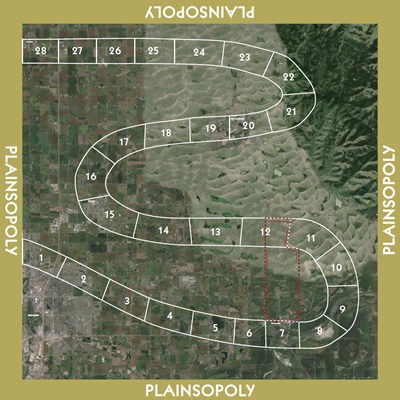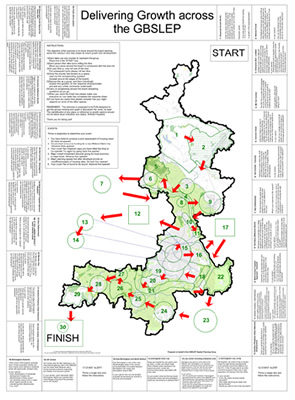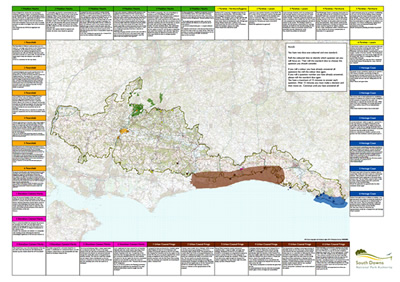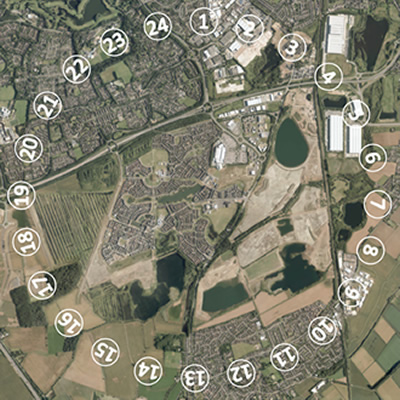
Design
It is important at the outset to think about WHO should be involved in the design of your exercise. Is it an expert group, or can it also be your participants themselves? Our advice is tailored to a project manager who runs the exercise, whether it uses a top-down or bottom-up model.
The Board
You can download pre-made boards of hypothetical landscapes, or make your own bespoke board to suit your specific setting and requirements. However, there are common design parameters that should apply to all boards:
- The board should be simple
- The board should have a strong visual impact, featuring an image in the background (preferably an aerial photograph or a map)
- The board should have no more than 28 questions/scenarios
- The recommended maximum board size is A1 long edge (841mm) to a side to maximise printability and legibility
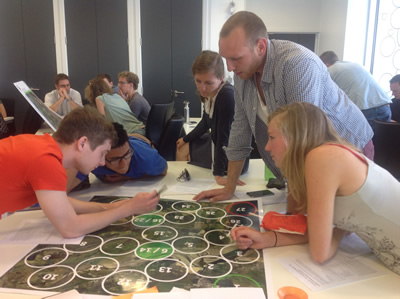
Climate-KIC West Midlands event

Hypothetical Boards
Choose from a selection of hypothetical boards that reflect different landscapes:
Making Your Bespoke Board
To make your own board you will need software capable of opening SVG (scaled vector graphics) files, such as Adobe Illustrator files. The sample boards and template were designed using Adobe Illustrator, part of the Adobe Creative Cloud.
If you do not have access to Illustrator, a number of free, open source programmes are available. Inkscape is recommended for the design of the board, and GIMP for editing images. The background image can be aerial photography or map-based.
If an A1 printer is not available or is too expensive you might want to consider the possibility of designing the board so it can be printed in pieces on an A3 printer and then joined together.
Rights To Images
You will need to ensure that you have obtained the rights to any images that are used. Google has a license agreement for the use of aerial images or mapping information from their website. Both maps and aerial photography can be freely used so long as the necessary attribution is made and the images are not amended in any way.
If you need to amend the aerial imagery, you will need to seek the permission of the supplier. Commercial aerial photography is also available but may be costly. For mapping data, Openstreetmap can provide rights-free information, subject to the terms of their license.
The Questions
Entrance and Exit Tasks
Design your entrance and exit tasks in conjunction with the questions on the board so that they form an integrated and logical package that meet your exercise goals.
Entrance Question/Scenario
In order to start your exercise it is important to consider an appropriate entrance question/scenario or task/briefing that addresses the goal of your exercise in a lively and stimulating manner. This ensure that participants get ‘hooked’ and engaged with the issues and outcomes you want them to consider. The way people react to the entrance task or statement is their first encounter with the game and can be crucial to the success of the exercise. So this needs careful thought.

Exit Question/Scenario
This is the question/scenario or task that addresses the “so what” aspect of the exercise. Participants have journeyed across the board answering questions and completing prescribed tasks. You now need to bring that all together with an explicit link activity/task or question that integrates this in a meaningful way. Here there needs to be synergy and development of the entrance task/question. If this is not properly thought through you risk people asking why they have done the exercise.
For example, our first PARTICIPOLOGY board game, Rufopoly, required participants to create a composite vision for the area using only their written answers and justifications from the questions answered. This then sparked a discussion around the barriers and opportunities to realising the visions created.
The Question Grid
Once you have created your board background, you need to design your question space layout. This can be any shape and ideally should create a logical, numbered ‘journey’ across your board.
The journey that is made should be random, dependent upon the throw of the dice. Therefore, you should consider the layout of the questions grid and the desired shape you want it to take.
Example question grid
Making Your Question Grid
A simple, circular question grid template, similar to that in the picture above is available for download in SVG format.
You can make your own question grid using SVG software - if you are unfamiliar with graphics software we recommend using Inkscape for designing the grid.
Designing Questions
In each space, you need a question or scenario for a group to consider. The questions can make reference to specific local issues, challenges or opportunities that are relevant, and/or to features that are visible within the space. They can also make reference to strategic issues/challenges affecting the whole area or a number of squares on the board. Try to make your boundaries specific in your question wording.
There is a resource bank of questions available to help you to design the questions for your board. The questions in the resource bank have been adapted from real-life situations by project partners. You can search for appropriate questions for your exercise based on key themes. We have also produced guidance for designing your own bespoke questions that draw on established principles of good practice.
It might be a good idea to enable your participants to identify the general issues and challenges from which questions can be developed. Involving your audience in the question design process can be time-consuming but ultimately very rewarding (see the Plainsopoly, Nebraska case study video).
Presentation of Questions
Once you have chosen the questions they should be numbered and then printed out, ideally on A4 card in at least 14 size font (for participants to read easily). They should be hole punched and the whole set linked together. We recommend at least two sets are made for each table. Other question cards can be printed out in the same way and linked together as separate sets.
Other Cards To Enrich Your Game Design
Role Play Cards
In designing your exercise you may wish to give people specific roles other than themselves. These character profile, role playing cards are based on real people and enable a richer role play experience than simple stereotypes. Each player can be given a role at random or however you decide.
We have role playing cards that give both occupational and professional role descriptions and portraits based on real people with an indication of key values to help with the game play.
Random Event Cards
It is worth considering having specific squares on the board that include random event cards. Akin to chance cards in Monopoly, they bring random events or crises into play that may affect the rest of the game or impact on a particular question (past or future). We have designed some examples but here is a great opportunity for your own creative thinking; go on, take a chance!

Evaluate
Evaluation is not a bolt on that occurs at the end of your exercise. It should be embedded in all stages, built around your vision of what success looks like. In the Design phase, there are key issues to build into your evaluation.
Design Evaluation Key Prompts
1. Hold regular progress evaluation meetings with your design team to ensure that people are happy with the game development. Take minutes of meetings and document the decision process and any changes.
2. Consider who needs to be involved in the design process and whether your participants help co-produce the resources.
3. Pilot test your initial designs with some of your target audience and managers to ensure that there are no unforeseen problems.
4. Ensure that you are clear how the results of the exercise will be collected and used by policy and decision makers (if appropriate) before you play the game. These factors will play an important role in how you design the whole experience.

